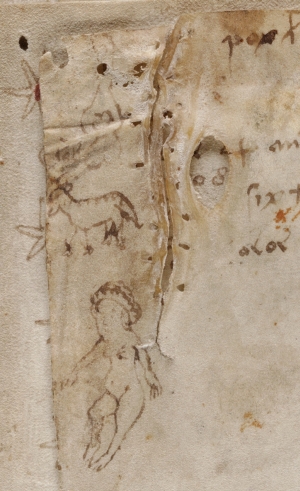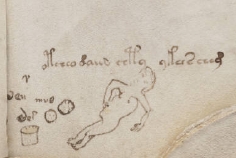I somehow had to catch your attention, didn’t I?
(Plenty of gut feeling and pointless ranting to follow.)
It has been a matter of debate for some time, whether the writings on the VM’s last page, f116v, is a part of the original manuscript or “extraneous” writing which has been added later — perhaps denoting an aborted solution attempt by a later would-be decipherer. This is supported by the mix of apparently latin and Voynichese characters.
I can’t really figure this. It wold be extremely unwieldy to work out a translation on the back of the very book one tries to decipher. I’d also expect more notes and scribbles on such a worksheet than there actually is.
What speaks for the “Michitonese” on f116v being written by the original author?
The illuminations on the top left of the page do. The style of the reclining woman, the odd creature*), and the heart-shaped object all very much resemble the other illustrations in the VM. (Compare, for example, with the “dead woman” on the bottom of f66v.) If you look closely, you’ll even find some VM characters half-hidden in the middle of this illustration, which makes it almost certain that the pictures on f116v were drawn by the original artist.


(See also here for a discussion of the ‘dead woman’.)
Then there is a tear on the vellum of this pages which shows sewing marks, which makes it look like somebody tried to keep the end with the illustrations attached to the main page. (f116r has no content in this corner of the page which would require saving.) If someone later had drawn the picture, he would have been wiser to use the free space on the page, rather than the shred prone to be torn off.
Also, the handwriting of the VM characters on this page very closely matches the manner of the rest of the corpus.
But if we assume the original author/artist sketched this doodle, he apparently had a reason to put woman, sheep, and ace of spades on the margin of the page. It was according to a plan — he needed the center part of the page, namely for his text.
And what did he write there? One school of thought holds it that the scribblings on f116v are actually a key to decipher the VM. Though I wish this were the case, this would be a bloody stupid thing to do by the VM author: The safety of any encryption lies in the secrecy of the method and of the key. Giving away the key would severely compromise the secrets hidden in the VM the minute somebody divined or guessed the enciphering method. And I simply think he was more clever than that.
Was it a decipherment attempt by The Man(tm) himself? I figure a scenario where he has devised his method, enciphered a short sample text and then deciphered it again to see if his method worked.
Assuming that the actual method is fairly simple, he wouldn’t have needed the notes, failed attempts, etc anyone who is just trying to find out which mechanism is used would inevitably have jotted down. And the author’s sample text could have been on a different piece of paper, making it more convenient to work out the plaintext on f116v.
This would also explain why the Michitonese is unreadable. Either The Man was a bit inept with his own device, or — more plausibly — f116v is an early attempt which showed that the Mk I of his algorithm was lossy, and the plaintext couldn’t reliably be retrieved. (This could also explain the ciphertext letters remaining in between latin letters — perhaps they couldn’t be unambiguously deciphered anymore.) Subsequentely, Mk II was developed, and the VM written in this cipher.**)
(Still, this doesn’t explain the drawings on this page and their positioning.)
Much of madness, more of sin, and horror the soul of the plot…
*) I still vote for a sheep or a lamb.
**) A slightly more disturbing alternative is that the failed decipherment attempt was performed by the author after the whole of VM was written. Meaning that, whatever was in there, was lost, because the algorithm didn’t allow perfect retrieval anymore.
I like your points, and would like to add my “gut feeling”: That this writing is the author “telling us something” about the VMs. Not a key, necessarily, but “explaining” something about it, or “defining” it. That is a totally intuitive sense I can’t support in any way.
But something specific which has interested me is the seeming inclusion of “porta” in the sentence. This is of course often thought of as a possible reference to “gate”, or “door”, as in a “way in” to the Voynich… like a key to the solution. That may be correct, but I find it an interesting coincidence that in the most mysterious cipher manuscript known to man, one of the few (only?) recognizable Latin words happens to also be the name of one associated with cipher: Giambattista Della Porta. What are the odds of that? Rich.
About extraneous characters anywhere on the manuscript, if that is close enough to the subject.
Amorphous pieces of the puzzle, an outline.
For each category of added writing.
Quality.
a) Unfamiliarity with Latin letters.
b) Infirmity.
c) Legibility was unimportant.
d) Purposefully vague.
Timeframe (named according to possession):
1) Before Rudolph.
2) During Rudolph.
3) After Rudolph but before Kircher.
4) During Kircher.
5) After Kircher.
Of the twenty possibilities (times the number of writers + whatever can be added), can some be eliminated to form a boundry for theories? As usual, everything here might have been discussed before but, if so, not everyone is aware of it.
Start with (a-1).
Hi Elmar,
A nice coincidence that we were thinking about basically the same thing at the same time:-
http://www.ciphermysteries.com/2009/04/11/a-guide-to-leonardo-da-vincis-handwriting
Can it ~really~ be true that all these marginalia were (basically) added by the original author? How things have changed since 2006! =:-o
Cheers, ….Nick Pelling….
“A slightly more disturbing alternative is that the failed decipherment attempt was performed by the author after the whole of VM was written. Meaning that, whatever was in there, was lost, because the algorithm didn’t allow perfect retrieval anymore.”
Hey what better way to hide information for a thousand years than to encode it using a cipher even the original author couldnt crack?
There is a key to cipher the Voynich manuscript.
The key to the cipher manuscript placed in the manuscript. It is placed throughout the text. Part of the key hints is placed on the sheet 14. With her help was able to translate a few dozen words that are completely relevant to the theme sections.
The Voynich manuscript is not written with letters. It is written in signs. Characters replace the letters of the alphabet one of the ancient language. Moreover, in the text there are 2 levels of encryption. I figured out the key by which the first section could read the following words: hemp, wearing hemp; food, food (sheet 20 at the numbering on the Internet); to clean (gut), knowledge, perhaps the desire, to drink, sweet beverage (nectar), maturation (maturity), to consider, to believe (sheet 107); to drink; six; flourishing; increasing; intense; peas; sweet drink, nectar, etc. Is just the short words, 2-3 sign. To translate words with more than 2-3 characters requires knowledge of this ancient language. The fact that some symbols represent two letters. In the end, the word consisting of three characters can fit up to six letters. Three letters are superfluous. In the end, you need six characters to define the semantic word of three letters. Of course, without knowledge of this language make it very difficult even with a dictionary.
And most important. In the manuscript there is information about “the Holy Grail”.
If you are interested in this topic, I am ready to provide detailed information.
Nikolai.
Nikolai,
This sounds all very interesting, though I have to say that solution suggestion similar to yours show up quite regularly, and their champions also regular have to give up again: It’s never been difficult to project a number of VM words on to plaintext words, but AFAIK *none* of the decipherers was able to do so for any significant amount of text.
But don’t let this stop you — one person has to be the one with the first correct answer. ;-) I’m sure many people would be interested in the details of your theory. The best way to go on about it would IMHO be to compile a small PDF file or such of a few pages, and in that put down the decipherment algorithm you suggest, a few sample translations, and the method by which you arrived at your results. Be aware that unless can arrive at the same results as you with the algorithm you provide, you’re going to stand only a very small chance.
One thing I don’t understand: You speak of an “ancient language.” Can you tell us which language this is?